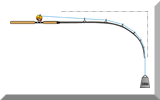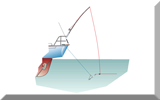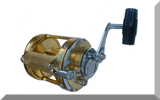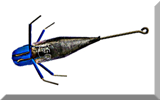- Home
- Fishing Techniques
- Wreck Fishing
Wreck Fishing in
Europe and the UK
The popularity of wreck fishing with UK anglers in particular owes much to the abundance of shipwrecks scattered around our shores. But we should remember that most of these, merchant and naval vessels alike, are a sad testament to the tragic losses at sea during the two world wars.
With their exact locations unknown, these wrecks attracted large and varied resident fish populations over a period of time.
Fishing these wreck marks was easy. Once a wrecking skipper had positioned his boat-load of anglers over one - even with basic tackle and skill - spectacular catches were made.
Tackle losses were similarly spectacular, but specimen ling, cod, pollock, coalfish and enormous conger soon filled the fish boxes.
But of course it couldn't last.
Inevitably, the easily reached inshore wrecks soon became fished out. But having had a taste of what wreck fishing could provide, many anglers were willing to trade actual fishing time in travelling much further offshore for the guarantee of a huge catch. And so evolved a new breed of professional charter boat skippers. Faster boats made wrecks far offshore accessible, and investment in electronic fish-finders and navigational aids (initially Decca and Loran, now replaced by GPS) made finding and recording their locations easier.
Whilst Alex Ingram's famed 'Redgill' imitation sandeel is still used today, its modern counterparts - shads, leadheads, jelly worms and the like - are even more popular choices for wreck fishing.
And along with artificial lures, tackle too, has similarly evolved. You won't see successful wreck anglers using the old fashioned 'broom stick' rods and similarly dated reels loaded with heavy, stretchy monofilament lines. Instead, they'll have got themselves far more effective wreck fishing gear, and catch a lot more fish as a result.
A good choice of a modern wreck fishing outfit would be a fast-actioned 30lb class braid boat rod fitted with a lever-drag multiplier reel loaded with 30lb breaking strain braid line. These modern braids (not to be confused with the older braided polyester lines) are very small diameter and ultra-low stretch.
But why are these braid line outfits so much more effective than the older gear? Well, they score in several crucial ways.
- the small diameter braid will offer much less resistance to the water letting you get your lure down close to the wreck where the fish are, rather than being streamed out astern of it by the current - where they're not.
- For the same reason, you'll be able to fish with lighter lures or sinkers.
- The low-stretch nature of the line and the sensitive rod will signal when your gear touches the wreck, so you can get out of it - fast!
- Similarly, bite detection will be instant.
There are two primary ways to go wreck fishing:~
- from a boat anchored uptide of it, or
- or one drifting over or close alongside it.
Wreck Fishing at Anchor
As the tide slackens off, drift fishing often becomes less productive. It's time for a spot of bottom fishing. The anchor should be dropped such that the boat settles down a short distance uptide of the wreck, so that your baited hook can be presented close alongside it on the sea bed.
Target fish will be conger and ling, both of which possess a formidable set of dentures so tackle (particularly for conger) should be stepped up accordingly. Incidentally, the ling's teeth are coated with an anti-coagulant, so if you get scratched by them you'll bleed for hours - so take care when handling these fish.
The Ledger Rig (with or without a Flyer)

The ideal rig would be a simple ledger rig fished on a 50lb class rod and a lever-drag multiplier reel loaded with 50lb breaking strain (even 80lb if really large conger are expected) braid line.
You can use with a flyer - a second hook link to pick up any fish feeding off the bottom - but the risk of tangles and having to deal with two heavy fish at the same time may make it a wise decision not to.
Hook traces should be of heavy mono, 200lb to 300lb, terminating in an 8/0 O'Shaughnessy hook. Delicate, it isn't. You won't be able to tie knots in mono of this size, you'll need to use crimped connections. Bait your hook with a whole fillet of fresh mackerel, or a whole squid ... and wait.
When it comes, the conger's bite will be almost unnoticeable, as it nervously mouths the bait. Once he's confident all is in order, he will grab it and beat a path back to the protection of the wreck with a deal of haste.
This is when you have to hang on and prevent him from doing so, as once he's back in the wreck it's game over. Unlike any other fish, eels can swim sternwards just as powerfully as they can in forward gear - and won't hesitate to do so to get back to the wreck.
Another trick is to spin like crazy, which will test you swivels to the limit. Ball bearing versions are a must for conger fishing.
Once you've got your conger clear of the wreck, make sure you play him out before he sees the boat, as it's when he's alongside that the power spinning will be turned on in earnest - and the last thing you want aboard is a lively, bad-tempered conger with malicious intent.
Other fish that may well put in an appearance when wreck fishing at anchor include cod, turbot (yummy!), monkfish (aka anglerfish) - and if you hook something that takes off at high speed, odds are it's a tope.
Wreck Fishing on the Drift
Drift fishing, as its name suggests, allows the boat to move freely with wind and current over the wreck. The direction of the drift depends of the strength and direction of the two factors that influence it - wind and current. Unless they're both going in the same direction, the direction of the drift will be somewhere between the two, and obviously closer to the predominant factor.
Clearly, when you're positioning your boat such for it to drift over a particular location you'll need to take this into account. If you're really lucky, the drift will carry you close alongside the full length of the wreck where your 'catching zone' time will be greatest whilst minimising the risk of snagging. The worst case is that you'll be carried over the beam of the wreck, where the opposite is true.
The Flying Collar Rig

One of the best rigs to use for wreck fishing on the drift is the flying-collar rig as shown here.
The Eddystone Eel shown here could be replaced Shad, Jelly Worm, a fresh mackerel fillet or a whole squid.
With the boat uptide of the wreck, just lower the whole shebang slowly to the seabed taking care that the long trace drifts out clear of the mainline and doesn't tangle around it. As the boat drifts toward the wreck, wind in on the reel at a steady rate counting the turns as you go.
When you have turned the reel handle say, 20 times or so, stop reeling and lower the rig back down to the seabed, or the wreck. Continue doing this until you hook up or it's time to wind in and motor back uptide to start a new drift.
When you feel a fish grab at the lure, don't strike, just carry on winding. The fish, if it had just snatched the tail of the lure will take another gulp, and instinctively dive for the wreck - he's hooked, you've got him!
Now you'll really appreciate your balanced outfit. The flexible but powerful rod will absorb the shock loads applied by the struggling fish and the reel drag will do its job by giving line when the fish lunges for freedom. If you remembered to count the reel turns, you'll know at what depth the fish are feeding and will be ready for action on the next drift.
If things don't seem to be going your way, try varying the technique. You could, for example, try a faster or slower retrieve rate. Or you could try winding in fewer or more reel turns before dropping back.
Experiment with the rig itself. Try different coloured lures, a longer or shorter leader, or a heavier or lighter lead.
The Jig Rig

Another rig for wreck fishing on the drift is the standard vertical jig set-up with a pirk or a deep-drop jig (an Abyss Speed Jig or similar jig would be a good choice) at the bottom and two or three muppets at approximately 18" intervals above it.
This is a straight-forward deep water jigging rig. Just lower the pirk until you feel it touch the wreck, then take a couple of quick turns on the reel to reduce the chance of snagging. Sweep the rod upwards, then lower it, allowing the lures to flutter back down again.
Repeat the process until you hook a fish or your arms drop off.
You can expect to get caught up now and again with this rig, whatever you do - as a consequence of which it's a very popular wreck fishing rig with tackle suppliers!
The techniques described here for wreck fishing will be equally successful for deep-water reefs.
Recent Articles
-
Sea Fishing Rods and Reels Must Be Compatible for a Balanced Outfit
Mar 08, 21 08:30 AM
A quality reel fitted to a quality rod doesn't necessarily make it a quality outfit. Your fishing rods and reels have to be properly matched if you're to get the best out of them, and here’s how -
Essential Lure Fishing Tips That All Saltwater Anglers Should Know
Mar 08, 21 04:51 AM
Which single lure fishing tip applies to trolling, jigging, baitcasting, spinning, fly fishing and any other branch of lure fishing? Well, it is the one at the top of this list -
Vital Jig Fishing Tips That You Really Cannot Afford To Miss!
Mar 07, 21 10:20 AM
Essential jig fishing tips to help you select the right lure for successful jig fishing, together with the techniques required to get the most out of your jig fishing outfit
























New! Comments
Have your say about what you've just read! Leave me a comment in the box below.